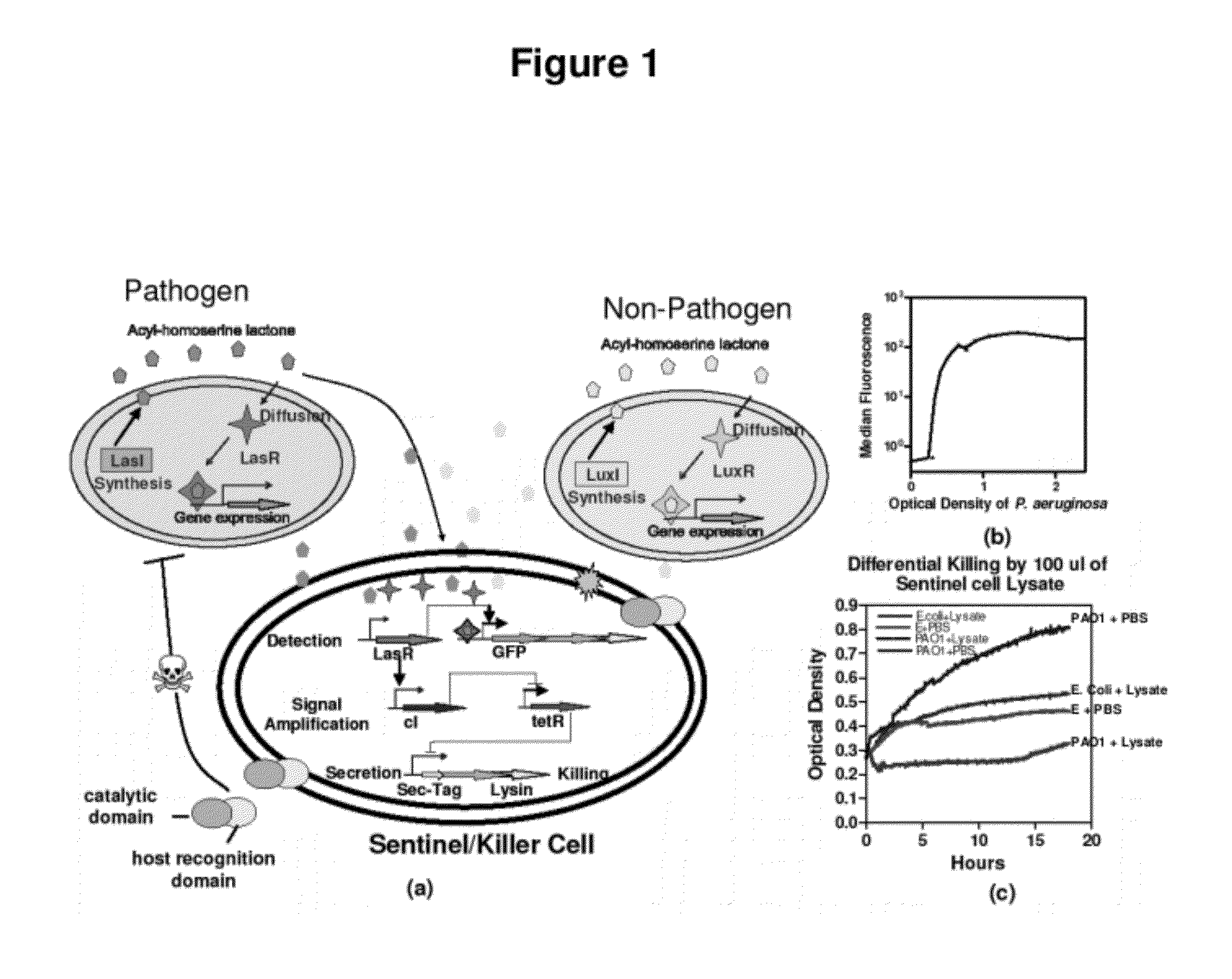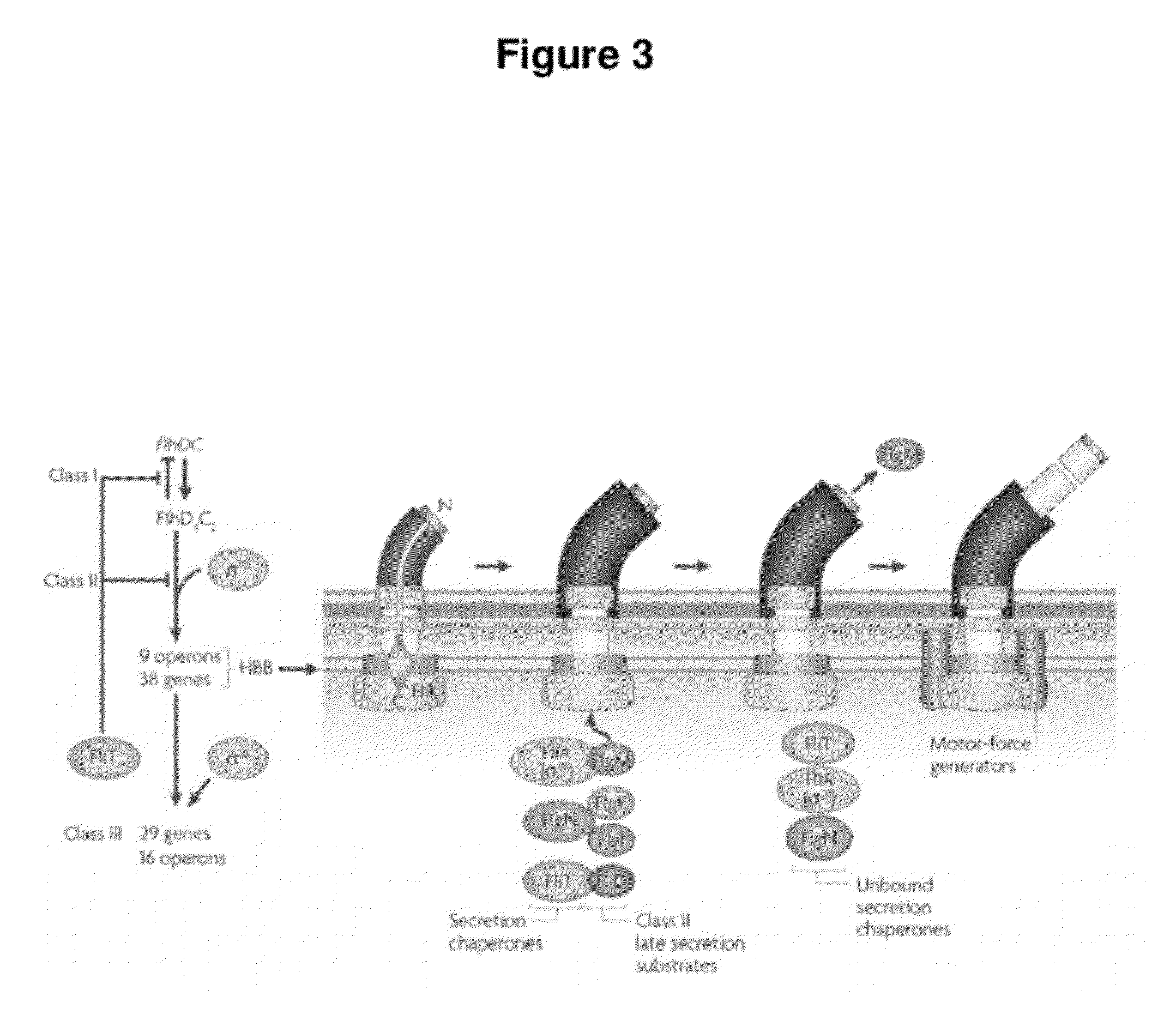Genetically programmable pathogen sense and destroy
a technology of genetic programming and pathogen detection, applied in the direction of immunological disorders, drug compositions, peptides, etc., can solve the problems of vicious outbreaks in confinement, control of sd1 is its resistance to antimicrobi, and the second or third-line drugs are much more expensive and potentially toxic, etc., to achieve the effect of convenient deploymen
- Summary
- Abstract
- Description
- Claims
- Application Information
AI Technical Summary
Benefits of technology
Problems solved by technology
Method used
Image
Examples
example 1
Sense and Destroy for P. Aeruginosa (PAO-1)
[0170]In 1917, a German professor named Alfred Nissle isolated a strain of E. coli from the feces of a World War I soldier who did not develop enterocolitis during a severe outbreak of shigellosis. Since antibiotics had not yet been discovered, Nissle used the strain with considerable success in acute cases of infectious intestinal diseases (such as salmonellosis and shigellosis). E. coli Nissle 1917 (EcN) is still used today and is one of the few examples of a non-LAB probiotic. This strain is particularly helpful in the management of gastrointestinal infectious disorders and infections affecting the urinary tract. Since then, the genome of EcN has been fully sequenced and it has exhibited a number of fitness factors, including for example, microcins, adhesins, and proteases. Besides these, it contains at least 6 different iron-uptake systems (enterobactin, salmochelin, aerobactin, yersiniabactin, EfeU) and lacks prominent virulence factor...
example 2
References for Example 2
[0196]1. Schultz, M. (2008) Clinical use of E. coli Nissle 1917 in inflammatory bowel disease, Inflammatory bowel diseases, 14(7):1012[0197]2. Nelson, E. J. and Harris, J. B. and Morris, J. G. and Calderwood, S. B. and Camilli, A. (2009) Cholera transmission: the host, pathogen and bacteriophage dynamic, Nature, 7(10):693-702[0198]3. Higgins, D. A. and Pomianek, M. E. and Kraml, C. M. and Taylor, R. K. and Semmelhack, M. F. and Bassler, B. L. (2007) The major Vibrio cholerae autoinducer and its role in virulence factor production, Nature, 450(7171): 883-886[0199]4. Ng, W. L. and Bassler, B. L. (2009) Bacterial Quorum-Sensing Network Architectures, Annual Review of Genetics[0200]5. Wingreen, N. S. and Levin, S. A. (2006) Cooperation among microorganisms, PLOS Biology 4(9): e299[0201]6. Svenningsen, S. L. and Waters, C. M. and Bassler, B. L. (2008) A negative feedback loop involving small RNAs accelerates Vibrio cholerae's transition out of quorum-sensing mode,...
example 3
References for Example 3
[0216]1. Schultz, M. (2008) Clinical use of E. coli Nissle 1917 in inflammatory bowel disease, Inflammatory bowel diseases, 14(7):1012[0217]2. Nelson, E. J. and Harris, J. B. and Morris, J. G. and Calderwood, S. B. and Camilli, A. (2009) Cholera transmission: the host, pathogen and bacteriophage dynamic, Nature, 7(10):693-702[0218]3. Higgins, D. A. and Pomianek, M. E. and Kraml, C. M. and Taylor, R. K. and Semmelhack, M. F. and Bassler, B. L. (2007) The major Vibrio cholerae autoinducer and its role in virulence factor production, Nature, 450(7171): 883-886[0219]4. Ng, W. L. and Bassler, B. L. (2009) Bacterial Quorum-Sensing Network Architectures, Annual Review of Genetics[0220]5. Wingreen, N. S, and Levin, S. A. (2006) Cooperation among microorganisms, PLOS Biology 4(9): e299[0221]6. Svenningsen, S. L. and Waters, C. M. and Bassler, B. L. (2008) A negative feedback loop involving small RNAs accelerates Vibrio cholerae's transition out of quorum-sensing mode,...
PUM
 Login to View More
Login to View More Abstract
Description
Claims
Application Information
 Login to View More
Login to View More - R&D
- Intellectual Property
- Life Sciences
- Materials
- Tech Scout
- Unparalleled Data Quality
- Higher Quality Content
- 60% Fewer Hallucinations
Browse by: Latest US Patents, China's latest patents, Technical Efficacy Thesaurus, Application Domain, Technology Topic, Popular Technical Reports.
© 2025 PatSnap. All rights reserved.Legal|Privacy policy|Modern Slavery Act Transparency Statement|Sitemap|About US| Contact US: help@patsnap.com



